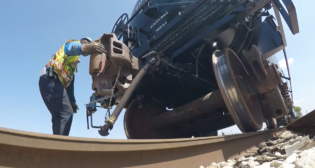
Wheel failures: Digging down to the roots
Written by William C. Vantuono, Editor-in-ChiefVertical split rims (VSRs) can cause high impact wheels or partial or catastrophic failure in railroad wheels. They remain an issue for railroads because of safety concerns and train delays. The illustration shows a wheel with a VSR.
TTCI continues to perform research on the root causes of VSRs with funding and direction from the AAR and FRA Office of Research and Development. The search for VSR root causes is focusing on a combination of two likely suspects: residual stresses, and shallow cracks in the wheel rim.
Compressive residual stresses discourage the propagation of cracks. Conversely, tensile residual stresses can promote crack growth. Residual stresses are intentionally created during the wheel manufacturing process, with residual compressive stress near the surface of the wheel rim and slight tensile stress deeper in the wheel plate. During service, the residual stresses increase due to cold-working, the strengthening that occurs under heavy loads. The region near the tread surface of the wheel is in residual compression, reacted by residual tension deeper in the wheel rim. Cracks that propagate into the residual tensile stress area of the wheel can become VSR failures.
In cooperation with Amsted Rail, TTCI is exploring the effects of accumulated mileage and high temperatures on axial residual wheel stresses. This research has shown a region of significant tensile residual stress becomes established in the wheel rim within the first few thousand miles of service. Elevated wheel temperatures, which can be experienced during prolonged braking, alter the residual stress pattern in the wheel rim. Preliminary results show some evidence that heating the wheel causes residual tension closer to the tread surface, thus potentially promoting vertical crack growth that could progress into a VSR failure. Additional measurement of the residual stress in heated wheels is under way. (For more information, see “Development of Railroad Wheel Rim Axial Residual Stress in Heavy Axle Load Service” by Cameron Lonsdale, et al., proceedings of the ASME Rail Transportation Division 2013 Fall Technical Conference.)
TTCI has also worked with Texas A&M University to model the mechanism of fatigue crack initiation using finite element analysis. This work modeled the evolution of residual stresses in a railroad wheel during rolling contact. The steady-state residual stress patterns predicted by the model agree well with experimental data. Two different analysis methods were applied to the modeling data to determine a likely crack initiation site. Both indices provided very similar results for the theoretical crack initiation site location, about 0.15 inch (4 mm) below the tread surface. The median depth of the vertical crack origin of service-failed VSR wheels is quite close to this prediction (0.17 inch), increasing confidence in the model. This model could be a useful tool in evaluating strategies for crack resistance.
Creating a VSR defect in the laboratory has proven difficult. In TTCI’s latest effort, a large slit was cut into the tread of a full-sized 36-inch-diameter wheel to simulate a vertical crack that had already propagated deep into the wheel rim. One of TTCI’s rolling load machines was used for the test, which applied vertical loads as high as 50,000 pounds on the wheel as it was rolled on a reciprocating piece of rail. Ultrasonic testing detected no crack growth from the time of the initial cut. The test was stopped after 1.8 million cycles.
Research has improved confidence in working theories for VSR formation, provided insight into wheel temperature as a potential contributor, and produced a computer tool that has potential to evaluate mitigation strategies.



